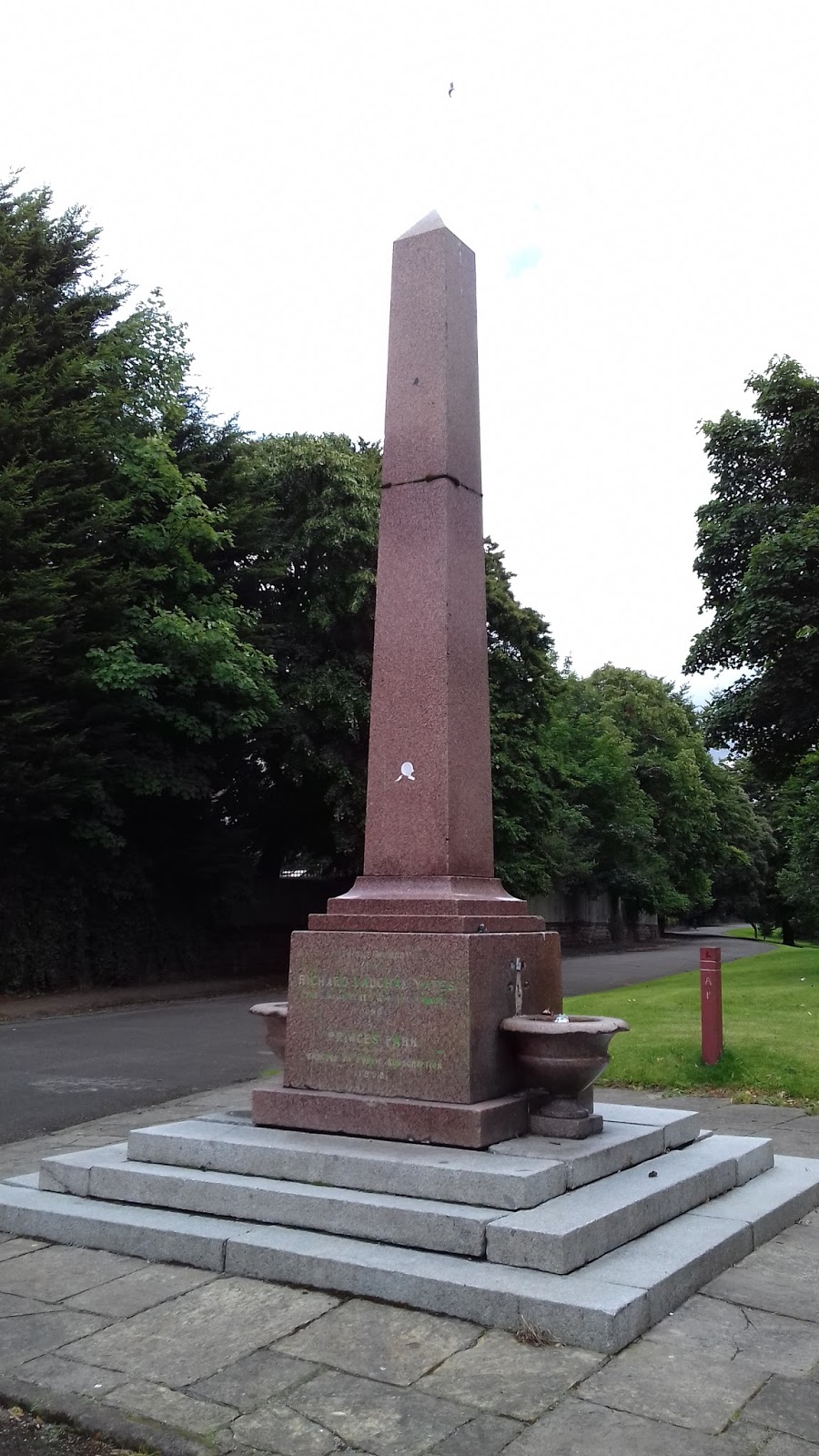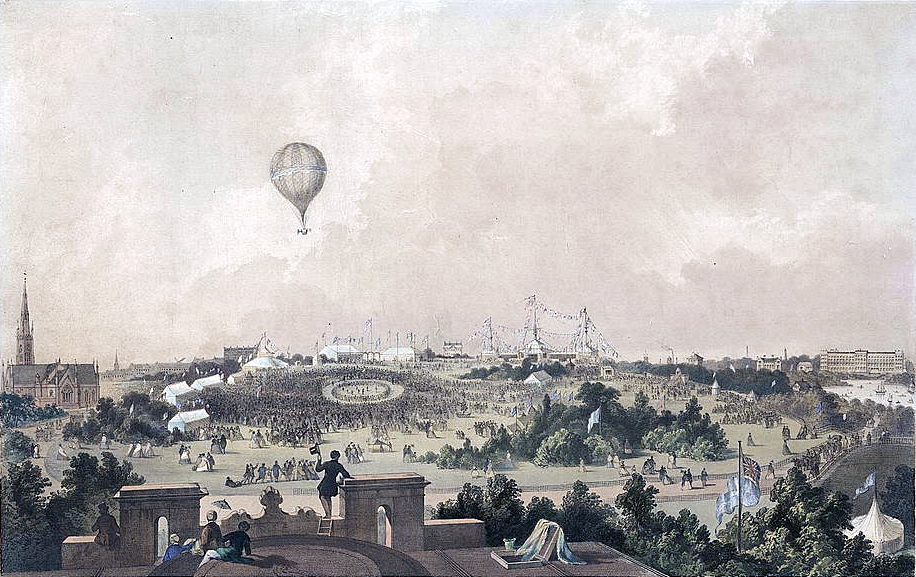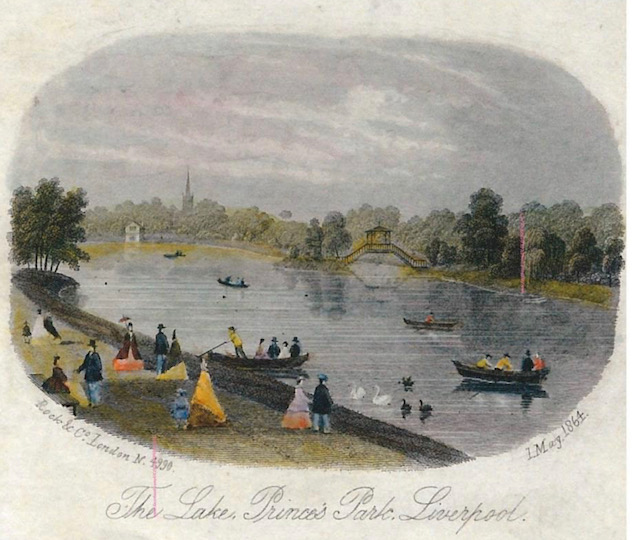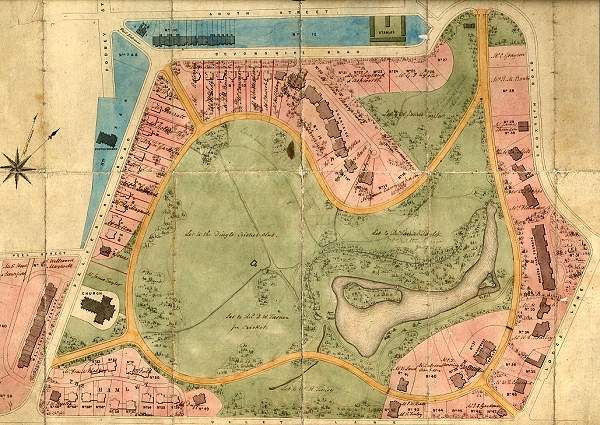Opened in 1842 - designed by Joseph Paxton
How the Park was born
The park was, for nearly four hundred years, part of the hunting forest of Toxteth and was a Royal Park. Not like the park we see today, the area would have been densely forested but in the 17th century the Royal Park status was removed with farmers and industrialists soon moving in to take advantage of the area. In the early part of the 19th century a private developer Richard Vaughn Yates, a prominent citizen of the city purchased an area of land which we now know as Princes Park. Yates planned to site grand houses on the park’s perimeter which, once sold, would cover the park’s cost. Designed by Joseph Paxton, the park was opened in 1842 with features which are to be found in many other of Paxton’s designs such as the perimeter carriage drive, lake, impressive entrances and footpaths which bring a surprise on every turn of one’s perambulations.
At the Sunburst Gates entrance there once stood the Doric Lodge, though again nothing remains due to it being bombed in 1940. Not too far into the park from the main Sunburst Gates entrance you will find the grave of “Judy” a donkey which gave rides to the children, who visited the park, for over twenty years. The gravestone is dated 1926.
Princes park founder
Richard Vaughan Yates
When you enter Princes Park through the Sunburst Gates you will see a polished red granite monument sculpted in Aberdeen. It was erected in 1858 in memory of the Enlightened Philanthropist and founder of Princes Park Richard Vaughan Yates. For many years it was also a drinking fountain.
Known as Rick and born in 1785 he was the third son of the Unitarian minister Rev. John Yates. Known as the speculative parson his father gave rousing anti abolitionist speeches from the pulpit in Paradise Street and Toxteth whilst at the same time having a secret share in a plantation in Jamaica. This was true of many Liverpool merchants of that time.
His mother was Elizabeth daughter of John Ashton of Woolton Hall and a wealthy heiress.
John Yates used the contacts of his father-in–law to built her fortune making the Yates’ one of Liverpool’s elite families.
Richard hated to see poverty in the city and dedicated much of his life to improving the social problems of the poor.
His hope had been to persuade Liverpool Corporation to invest in the purchase of the land but they refused so he did this himself. It was an immense cost [over £5m today] and it almost crippled him financially. He then employed Joseph Paxton to design & create the park as a recreation area for the benefit of public health & enjoyment. The park provided an example to cities across England.
As well as this he contributed generously and regularly to all of the principal charities of his native city taking special interest in education of the poor. He continued to fund the school his father had established - Harrington Board School in Stanhope Street. It was one of the city’s first schools and was on the site of what is now Cain’s Brewery car park.
Richard was an enthusiastic patron of the arts and played a key role in the foundation of the Liverpool Mechanics’ Institute and the College of Arts to create very affordable educational opportunities in the city. This was so successful that a new building was constructed in Mount Street in 1837. Seven years later Charles Dickens delivered a lecture to 1200 people there. During his stay he was entertained at Richard’s mansion in the Dingle.
The 1847 Tithe Schedules show that the Yates family owned a large part of the land in Dingle.
Richard built himself a fine mansion with beautiful grounds extending back to the head of Dingle Glen. It was known as The Shrubberies. His father lived on the site now occupied by the Turner Memorial Home and Toxteth Annexe.
When Richard died on 1st December 1856 the flag at Liverpool Town Hall was lowered to half-mast as a token of respect and appreciation. He was buried in the family grave at the Ancient Toxteth Chapel. Without his generosity Liverpool could well have been a much poorer place.
Little is known of Richard’s descendants. His first wife died young. He remarried and had three sons and two daughters. His great nephew Henry Yates Thompson was also a philanthropist and funded the construction of Sefton Palm House and The Isla Gladstone Conservatory in Stanley Park. He was awarded the Freedom of Liverpool in recognition.
Research and words by Fay Carter
Original Park plan
The Boathouse
The Boathouse was built around 1842, probably by John Robertson supervised by, Park designer, Joseph Paxton. Originally timber framed on a rock-faced stone base, stone chimney under a tiled roof. The design was in the chalet style with overhanging eaves over external stairs. A fretted balcony was included to square windows on the land side and enriched mouldings as a frieze. By the mid 1980’s the balcony was
missing and fire destroyed the remaining fabric in the 90’s.
Sunburst Gates
Approaching Princes Park along Princes Avenue, the first glimpse the visitor has of the Park is the Sunburst gates. These original gates, loving restored, are an excellent example of mid nineteenth century workmanship and lead into the most wonderful of public spaces in Liverpool. The interested observer will note that the gates are decorated with sections in 23.5 karat gold leaf.
The Old Boathouse
The Lake
The Serpentine like lake has been a feature of the park right from its original design. With an island and boathouse, of which sadly only the base remains, the lake has been a source of enjoyment for generations. Now, in 2020, the lake is nearing the end of a restoration project which has seen much work done to improve the banks and the installation of a bore hole to keep the water, in the lake, at a stable level.
The island
Once linked to the mainland of the park via a Chinese style bridge, the island has, in recent years, become a part of that mainland with the combined build up of debris and loss of water. Alongside the lake restoration, plans have been put in place to re-bridge the island as part of a permanent memorial to the well known freedom fighter, Nelson Mandela. The island will be home to an installation which will reflect Mandela’s love of gardens and will provide an area for learning and reflection events can be held. .
“Stop every now and then, just stop and enjoy.”
Judy the Donkey
Judy the Donkey was buried on the site of her favourite grazing spot on 12th August 1926. She had served in Princes Park for 21 of her 26 years.
Although it was a public park, much of it was still privately owned and residents had their own keys to the private gardens.
In 1976 the grandson of the parks’ superintendent remembered that Judy was not just a donkey for children’s pleasure riding but a working animal helping the gardeners by drawing a little cart carrying leaves, turf, plants, soil or rocks.
She also pulled the cart loaded with coal as far as Tarbock one day. She was familiar with the journey and always stopped on both outward and return journeys at a driveway entrance in Childwall refusing to budge until she had been rewarded with sugar!
Most of the children who came to the park would pet & feed her.
Long after Judy had died two elderly ladies who remembered her fondly from their childhood said that they used to save their pennies for sticky buns for Judy.
They also said that Judy’s teeth were badly stained and not just by the sweets. She enjoyed chewing slices of strong thick-twist tobacco, which men would cut for her occasionally!
Hundreds of children mourned Judy’s death but were delighted when a
replacement donkey called Judy the Second arrived to take up duties.
Research and words by Fay Carter
The Grand Fancy Fayre
In August 1849 a very splendid festival took place in Princes Park. It lasted for 4 days with well over 10,000 attending each day. There were long queues for tickets, priced at half a crown, at the main entrance gates.
At the opening 10 military bands positioned around the park struck up the National Anthem “producing a most thrilling effect”.
For those not fortunate enough to be able to attend, the events were recorded daily in great detail by the Liverpool Mercury.
A huge pavilion or marquee over 100 metres long topped by a profusion of colourful flags was the main feature. By the entrance to this Lancashire bell-ringers played at intervals.
Inside many tables and stalls had been organised by a committee of ladies who had set out richly made and beautiful articles including chairs, cushions, ottomans, fancy knitting, children’s clothes & toys, pictures and much more.
On show was a model of the new Corporation Baths due to be built in Cornwallis Street.
Also on display were more unusual objects such as a giant land tortoise from the Galapagos Islands supposed to be 200 years old. It had unfortunately died on the journey to England!
Next to the pavilion were flower tents where many specimens were judged and awarded prizes. Admired plants from all over the country and valuable specimens from around the world were exhibited.
There were many conical refreshment tents which sold confectionary, wines and more substantial meals, under the direction of the great master of caterers from the Waterloo Hotel.
A small charge was made for those who wished to view a monster loaf and cheese or the silverware presented to the Swedish songstress Jenny Lind in thanks for her performances earlier in the year which had raised substantial funds towards an extension to Toxteth Hospital.
There were jugglers, and performers available for people to watch. A famous German ventriloquist Herr Von Joel imitated animals and birdsong and sang famous songs. Mr. Punch entertained from his own tent and Miss Twinch’s dog Toby “could not have performed his part better”.
By the lake the Telegraphic Company had a tent where experiments were performed using a galvanic battery.
On the Friday, just before a rainstorm, The Royal Victoria air balloon was inflated and launched carrying away three gentlemen. A few hours later the aeronauts descended safely, but very wet, not far from Runcorn.
The final day of the event ended with a display of fireworks accompanied by military bands and a discharge of fire balloons.
The event had been a huge success and the profits made were divided between the Infirmary, Northern and Southern and Toxteth Hospitals. Each received £3197 15s 4d which is worth around half a million pounds today.
Research and words by Fay Carter
The Park today
As can be seen from the original plan, drawn at the time the park was constructed, little has changed for the visitor to Princes Park, with its lake, Sunburst Gates, memorial to Richard Vaughan Yates, Carriage Drive and numerous paths through the Park. Today the visitor will enjoy enhancements such as tennis courts, a children’s play area, labyrinth and the much acclaimed Henge.
FoPP Planting
For most of the time the Friends have existed, we have managed the trees of the Park and have planted many different species which relate to those which Paxton would have had available when the Park opened in 1842. The Cherry tree walk is something special to see in the weeks the trees are in blossom. If you would like to help us with our tree management, please go to our Volunteer page.
Ready to help?
Please consider joining us as a volunteer!






